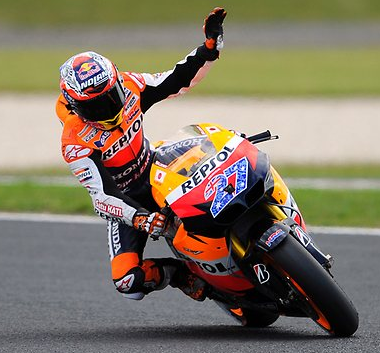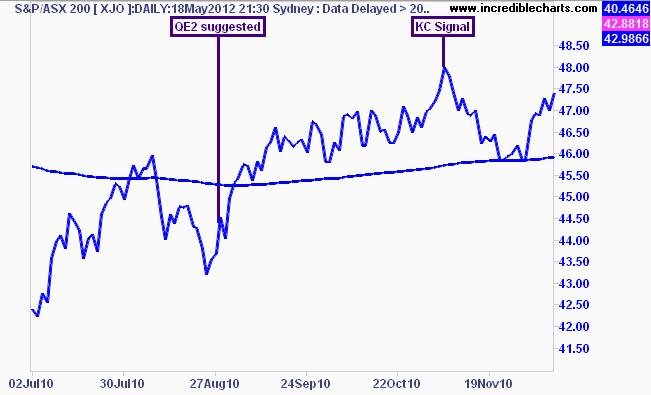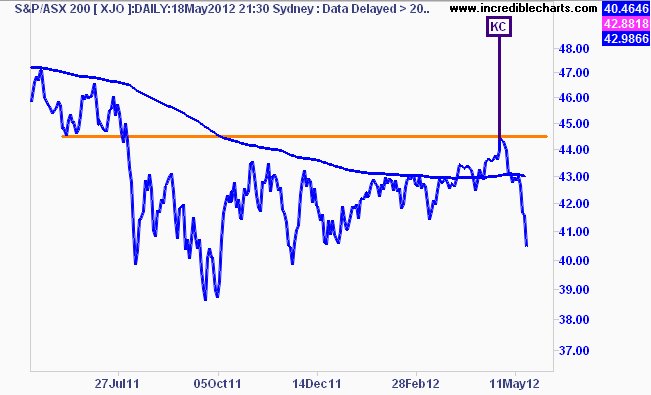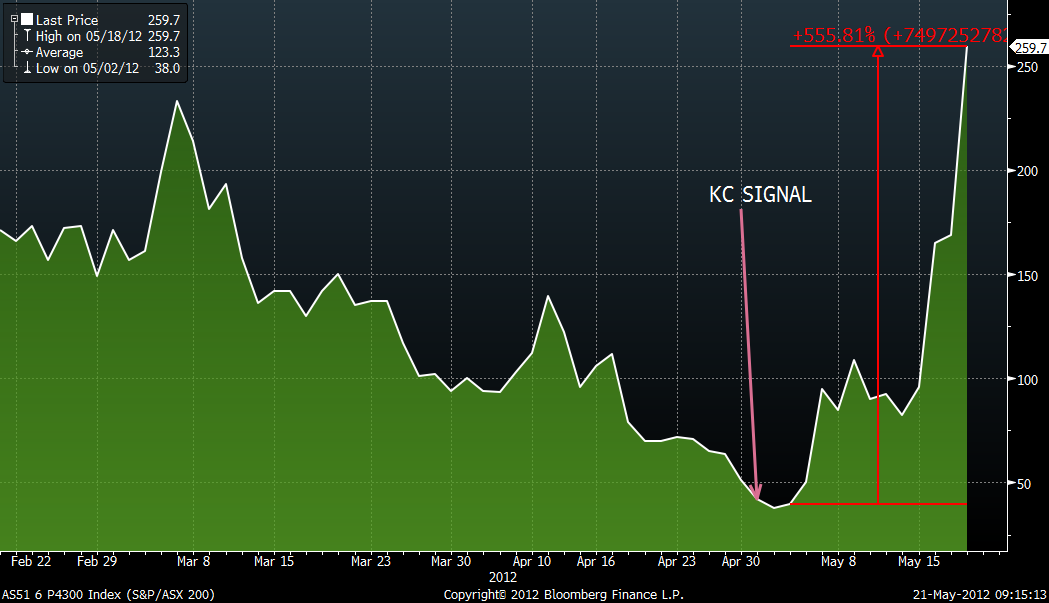
by Chris Becker
Amidst the market sell-off in recent weeks, there was an interesting piece of news from the world of motorsport, with MotoGP world champion Casey Stoner – at the ripe age of 26 – announcing his retirement at the end of this season.
What does this have to do with anything? Well, I’m an avid fan of MotoGP and Casey Stoner in particular, and I named a technical trading indicator I created after him (actually it was his rival , Valentino Rossi that came up with the inspiration for the name), called the “KC Signal”.
Its important because (as regular readers of ASX Shares Daily, formerly known as Trading Day would know), on Tuesday 1st of May, the KC Signal clanged. Do I need to remind you what happened next?
First, unlike the real Casey’s ability, and like most technical indicators, the KC Signal is far from perfect, and its reliability should be tempered by its coincidence with the real “perfect indicator” – I was on holidays for the last week (and a “working” holiday the week before, in Melbourne).
It seems whenever I go on holidays/have a big life change, the markets go nuts. In 2010 I went on a major European holiday and forgot to close some nearly worthless put options that I had used as a hedge in the preceding months. Just like this holiday, I always close out my open positions (long or short) when on holidays, but leave my option hedges open (since I’ve already paid for them).
Those particular options then went up about 2000% in value as the Greek Crisis Mk 1 unfolded whilst I watched aghast (and unable to get internet access) drinking lemoncello on the Amalfi Coast. Almost enough to pay for the holiday, but the real cost was not being able to take full advantage of the volatlity!
Moving house, new addition to household – anything like that over the last 5 years – market volatility (up and down) explodes. I’ll send you my 2013 schedule on request if you like..
Back to business.
I have ceaselessly tried to explain here at MacroBusiness that its not about getting it right all the time that counts, its how you manage portfolio allocation and risk management after you make a decision. The need to be right all the time – in your investment choice or your narrative about how the world works – is a fruitless, wasteful exercise regardless if you’re an investor, a trader, a businessman or a politician.
Peter L.Brandt, a proprietary commodity trader, summed this up nicely in a recent post:
There is a huge difference between (the) three drivers or motives for being involved in the markets:
- An obsession to be right
- A blind bias about some narrative (silver is a great example)
- A goal to be profitable at the end of the year no matter how it can be done
What category are you in? Being profitable is always more fun than being right…
Throughout my daily and weekly analysis of the Australian stock market, I have explained that whilst the post-Xmas rally on international markets (through continued monetary and fiscal easing, plus the ECB’s LTRO) could push our own market up even higher, that the risks were too great for a larger asset allocation.
The KC Signal provided a tactical method of responding to this strategic overview, and the asymmetric bet payoff was huge, as this option price chart shows (June 4300 put option):
Finally, I’m not going to divulge the exact indicator, given it was something I created over countless hours of modeling, research and tinkering with data and strategies (but I have hinted at it here before). It’s very name indicates its utility – it’s a “too fast” indicator that signals when a market/security has had too good a run up and will likely revert to its previous trend a modest dip or overshoot entirely with a spectacular fall.
This provides three options (literally):
- to sell into strength (i.e take some profits, or walk away completely)
- to increase your existing position at a lower price point (as the price reverts to the mean uptrend)
- to hedge against a substantial fall
The previous KC Signal on the ASX200 was on the 5th of November, 2010, when the US Federal Reserve announced QE2.
In this case, all options were worthwhile, for a trader or investor, with the first providing a lock in of a medium term gains, the second an opportunity to buy in again in late November after markets had a normal (“Tom Jones”) correction and thirdly, as well as a nice payoff from some relatively hedges (e.g just buying a USD ETF would do the trick here).

The question is – does this KC Signal show a repeat of the 2010 one? Are we having a usual “Tom Jones” type risk correction, or is this a harbinger of greater falls to come? Do you really want to be buying back in right now?
I can feel another holiday on the horizon.
You can find me on Twitter here.
Disclaimer: The content on this blog should not be taken as investment advice. All site content, including advertisements, shall not be construed as a recommendation, no matter how much it seems to make sense, to buy or sell any security or financial instrument, or to participate in any particular trading or investment strategy. The author has no position in any company or advertiser reference unless explicitly specified. Any action that you take as a result of information, analysis, or advertisement on this site is ultimately your responsibility. Consult someone who claims to have a qualification before making any investment decisions.

